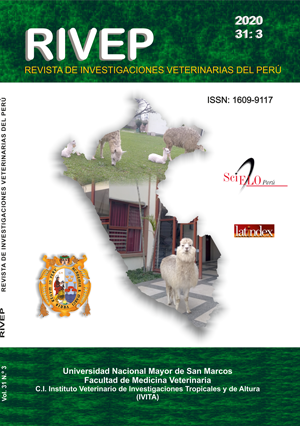Bovine Leukosis
An updated review
DOI:
https://doi.org/10.15381/rivep.v31i3.16913Keywords:
bovine leukaemia virus, diagnosis, control, genetic resistance, BoLA-DRB3Abstract
Enzootic bovine leukosis, caused by bovine leukaemia virus (BLV), is the most frequent neoplasm in dairy cattle. Both dairy and beef cattle are susceptible to BLV infection and BLV-associated lymphosarcoma. However, the disease is more prevalent in dairy herds, mostly because of the management practices in dairy farms. The pathogenicity of BLV in cattle is associated with the genetic background of the animal. Most BLV-infected cattle are asymptomatic; hence infection may be overlooked when infection rates are relatively low. BLV spreads slowly and silently when control measures are not undertaken. BLV causes important economic losses, not only because of the death of animals with lymphosarcoma but also because of restrictions in the trade of infected animals and their by-products. Different strategies to control the virus have been attempted, each for the different epidemiologic situations. At present, no treatment or vaccine has proven effective for the control of BLV. When the prevalence of infection is low, below 10 to 15% of infected animals, it is recommended to identify and cull the totality of infected cattle. This approach is not suitable for herds with high prevalence of infection, as is the case of most dairy herds in Argentina. The genetic selection of resistant animals emerges as a natural approach for the containment of BLV dissemination, and thereby, for the control of lymphosarcoma.
Downloads
Downloads
Published
Issue
Section
License
Copyright (c) 2020 Silvina Elena Gutiérrez, Claudia María Lützelschwab, Clarisa Natalia Barrios, Marcela Alicia Juliarena

This work is licensed under a Creative Commons Attribution-NonCommercial-ShareAlike 4.0 International License.
AUTHORS RETAIN THEIR RIGHTS:
a. Authors retain their trade mark rights and patent, and also on any process or procedure described in the article.
b. Authors retain their right to share, copy, distribute, perform and publicly communicate their article (eg, to place their article in an institutional repository or publish it in a book), with an acknowledgment of its initial publication in the Revista de Investigaciones Veterinarias del Perú (RIVEP).
c. Authors retain theirs right to make a subsequent publication of their work, to use the article or any part thereof (eg a compilation of his papers, lecture notes, thesis, or a book), always indicating the source of publication (the originator of the work, journal, volume, number and date).



